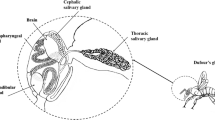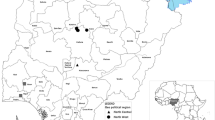Abstract
Chemical analyses revealed that the labial gland complex of worker honeybees possesses a series of hydrocarbons dominated by odd-numbered carbon chain alkanes along with minor amounts of alkenes and branched alkanes. Foragers contained significantly more secretion than nurse bees. Experiments with bees from colonies induced to have a division of labor independent of age revealed that the differences in the amount of secretion were task, but not age dependent.
Similar content being viewed by others
REFERENCES
ARNOLD, G., and DELGE-DERACHEN, B. 1978. Nouvelles données sur l'équipment enzimatique des glandes salivaries de l'ouvrier d'Apis mellifera (Hymenoptera Apidae). Ann. Sci. Nat., Zool. Biol. Anim. 20:401-422.
ARNOLD, G., QUENET, B., CORNUET, J. M., MASSON, C. DE SCHEPPER, B., ESTOUP, A. and GASQUI, P. 1996. Kin recognition in honey bees. Nature 379:498.
BERGMAN, P., and BERGSTRöM, G. 1997. Scent marking, scent origin and species specificity in male premating behavior of two Scandinavian bumble bees. J. Chem. Ecol. 23:1235-1251.
BERGSTRöM, G., SVENSSON, B. G., APPELGREN, M., and GROTH, I. 1981. Complexity of bumble bee marking pheromones: Biochemical, ecological and systematical interpretations, pp. 175-183, P. E.
Howse, and J. L. Clement, (eds.). in Biosystematics of Social Insects. Academic Press, London.
BREED, M. D. 1998. Recognition pheromones of the honey bee. BioScience 48:463-470.
CRUZE LANDIM, C. 1967. Estudo comparativo de algumas glandulas das abelhas (Hymenoptera, Apoidea) a respectivas imlicacoes evolutivas. Arg. Zool. 15:177-290.
GENIN, E., JULLIEN, R., PEREZ, F., FONTA, C., and MASSON, C. 1984. Preliminary results on the chemical mediators of the bumble bee Bombus hypnorum. C. Rd. Acad. Sci. III. 299:297-302.
HEFETZ, A., TAGHIZADEH, T., and FRANCKE, W. 1996. The exocrinology of the queen bumble bee Bumbus terrestris (Hymenoptera: Apidae, Bombini). Z. Naturforsch. 51C:409-422.
HOVORKA, O., URBANOVA, K., and VALTEROVA, I. 1998. Premating behavior of Bombus confusus males and analysis of their labial gland secretion. J. Chem. Ecol. 24:183-193.
HUANG, Z. Y., and ROBINSON, G. E. 1992. Honey bee colony integration: Worker-worker interactions mediate hormonally regulated plasticity in division of labor. Proc. Natl. Acad. Sci. U.S.A. 89:11726-11729.
HUANG, Z. Y., and ROBINSON, G. E. 1996. Regulation of honey bee division of labor by colony age demography. Behav. Ecol. Sociobiol. 39:147-158.
HUANG, Z. Y., PLETTNER, E., and ROBINSON, G. E. 1998. Effects of social environment and worker mandibular glands on endocrine-mediated behavioral development in honey bees. J. Comp. Physiol. 183:143-152.
KINDL, J., HOVORKA, O., URBANOVA, K., and VALTEROVA, l. 1999. Scent marking in male premating behavior of Bombus confusus. J. Chem. Ecol. 25:1489-1500.
KORST, P. J. A. M., and VELTHUIS, H. H. W. 1982. The nature of throphallaxis in honeybees. Insects Soc. 29:209-221.
KRONENBERG, S., and HEFETZ, A. 1984. Role of labial glands in nesting behaviour of Chalicodoma sicola (Hymenoptera: Megachilidae). Physiol. Entomol. 9:175-179.
KULLENBERG, B., BERGSTRöM, G., and STALLBERG-STENHAGEN, S. 1970. Volatile components of the cephalic marking secretion of male bumble bees. Acta Chem. Scand. 24:1481-1483.
KULLENBERG, B., BERGSTRöM, G., BRINGER, B., CALBERG, B., and CEDERBERG B. 1973. Observation of scent marking by Bombus Latr. and Psithyrus Lep. males (Hym. Apidae) and localization of site of production of the secretion. Zoom. Suppl. 1:23-30.
LAHAV, S., SOROKER, V., HEFETZ, A., and VANDER MEER, R. 1999. Direct behavioural evidence for hydrocarbons as ant recognition discriminators. NaturwissenSchaften 86:246-249.
MINCKLEY, R. L., BUCHMAN, S. L., and WCISLO, W. T. 1991. Bioassay evidence for a sex attractant pheromone in the large carpenter bee, Xylocopa varipuncta. J. Zool. 224:285-291.
MORITZ, R. F., and HILLESHEIM E. 1990. Trophallaxis and genetic variance of kin recognition in honey bees, Apis mellifera L. Anim. Behav. 40:641-647.
PAGE, R. E., JR. METCALF, R. A., METCALF, R. L., ERICKSON E. H., JR,. and LAMPMAN, R. L. 1991. Extractable hydrocarbons and kin recognition in honey bee (Apis mellifera L.). J. Chem. Ecol. 17:745-756.
ROBINSON, G. E., PAGE, R. E., STRAMBI, C., and STRAMBI A. 1989. Hormonal and genetic control of behavioral integration in honey bees colonies. Science 246:109-112.
SCHULTZ, D. J., HUANG, Z. H., and ROBINSON, G. E. 1998. Effects of colony food shortage on behavioral development in honey bees. Behav. Ecol. Sociobiol. 42:295-303.
SIMPSON, J. 1960. The function of the salivary glands of Apis mellifera. J. Insect. Physiol. 4:107-121.
SOROKER, V., and HEFETZ A. 2000. Hydrocarbon site of synthesis and circulation in the desert ant Cataglyphis niger. J. Insect Physiol. 46:1097-1102.
SOROKER, V., VIENNE, C., NOWBAHARI, E., and HEFETZ, A. 1994. The postpharyngeal gland as a “Gestalt” organ for nestmate recognition in the ant Cataglyphis niger. NaturwissenSchaften 81:510-513.
Author information
Authors and Affiliations
Rights and permissions
About this article
Cite this article
Katzav-Gozansky, T., Soroker, V., Ionescu, A. et al. Task-Related Chemical Analysis of Labial Gland Volatile Secretion in Worker Honeybees (Apis mellifera ligustica). J Chem Ecol 27, 919–926 (2001). https://doi.org/10.1023/A:1010330902388
Issue Date:
DOI: https://doi.org/10.1023/A:1010330902388




